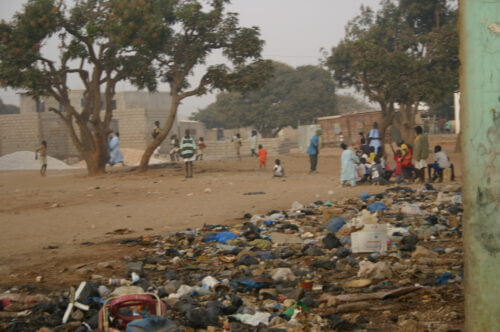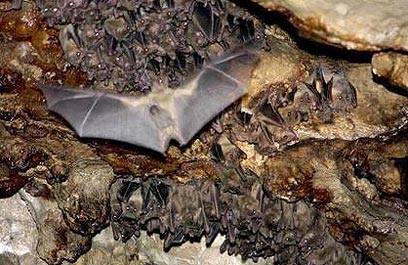This is according to a report published by the World Health Organization, which was published after the issue made headlines due to the Corona epidemic

With COVID-19 at the top of the public agenda, it becomes clear once again that many of the diseases that afflict us are caused by criminal neglect and serious damage to the natural environment. By being distracted while behaving carelessly, we have made the world a less healthy place.
The facts show that we have caused damage to the natural environment, the results of which are serious harm and an increasing risk to our health. According to the World Health Organization 23% of deaths in the world are caused by an unhealthy environment. World Economic Organization Lists the five main dangers to humanity as related to damage to the environment.
Here are our failures - the ways in which we harmed the environment in a way that harms our health:
Air Pollution
Everyone must breathe air to live, but according to the World Health Organization Nine out of ten people in the world breathe polluted air. Tiny particles from burning petroleum products, coal, vegetable matter and garbage enter the lungs and blood and cause a variety of diseases. Methane emitted from industry and agriculture and ozone at ground level contribute to asthma and chronic respiratory diseases, Air pollution causes lung cancer and death due to respiratory diseases.
Air pollution causes heart disease and death from stroke. More than 90% of deaths caused by air pollution occur in countries where the per capita income is low.
According to the report in many US cities, The level of air pollution is high and in the US as a whole about half of the population lives in areas where the ozone level is high and tiny particles harm health. When linking all this to the outbreak of the COVID-19, experts warn that air pollution contributes to the risk and damage of many diseases.
Contaminated water
A person needs 20 to 50 liters of water a day for drinking and basic hygiene. In many areas of the world, water quality is low due to pollution from household and medical waste, sewage, agriculture and industry. 80% of the "used" water returns to the system without purification, which puts about two billion people at risk of infection In infectious diseases such as cholera, dysentery, typhoid and more.
Since 1990 almost all the rivers in Africa, Asia, and South America are polluted.
The decisive and courageous call of the health organizations to maintain hygiene following the outbreak of the COVID-19 is faced with a situation where half of the world's population or fifty countries in the world There is no access to water and soap in their home.

the quality of the food
Everyone knows that quality food and a healthy menu contribute to health, but population growth and urbanization come with health problems related to poor nutrition. While close to a billion people in the world suffer from malnutrition, More than two billion are obese.
Which makes clear the fact that enough food is not the same as nutritious food. The increase in industrial food production caused the cheapening and availability of poor quality food, and thus today 60% of the energy supply from food comes from three types of grains: rice, corn and wheat.
The diets of two billion people lack vitamin and mineral components that are important for normal development. According to the World Health Organization, about a third of the world's population suffers from malnutrition, and in many regions the population is affected by poor nutrition, or by malnutrition that causes diseases such as Diabetes, cancer and stroke.
consumption of harmful products
The widespread use of insecticides causes not only environmental pollution but also damage to public health. While in 2001 a treaty was signed that prohibits the use of"Resistant organic materialsAfter all, in many developing countries the use of poisons continues and causes serious harm to which approximately 25 million people are exposed every year.
Food processing, packaging and adding flavors are a risk. In the evaluation of the health organization in 2015 it was found that "Processed meat may cause colon cancer". In the industry in the production of plastic and metal tools in some countries there is the use of substances that cause the disruption of hormone secretion systems and nerve damage.

infection from animals (zoonotic)
The continuous damage to habitats and natural areas for the development of agriculture, industry, infrastructure and residences reduces and blurs the boundaries of contact between humans and wild animals and thus enables the outbreak of epidemics. Added to this is the change due to the warming that improves the climate conditions for species of parasites and other hazards such as for example an increase in seasonal humidity that contributes to the ability of bacteria to survive, as international transportation links are connected, improved conditions are created for the spread of diseases between many countries within a few hours.
Increased resistance of bacteria to drugs
Since the middle of the 20th century, the use of antibiotics has been widespread in the treatment of humans and animals, as well as the addition of drugs to the feed of farm animals to encourage rapid growth. According to the "United Nations Food and Agriculture Organization" The use of antibiotics in farm animals will double within 20 years, as a result the effectiveness of drugs for people and animals will decrease, it is estimated that every year about 700,000 people die because of bacterial resistance to drugs.
Damage to natural medicines
About 60,000 species of plants, animals and bacteria are known which are used for the production of medicines.Species that make up a significant part of the pharmaceutical industry, out of about one hundred and fifty prescription drugs (in the USA), 118 have their origin in nature, mainly drugs for the treatment of cancer, but, due to human activity such as over-collection, damage to habitats and climate change, wild plants are damaged and disappear. It is estimated that about 15,000 plant species with medicinal properties are threatened with extinction and every year at least one species is lost from which medicines can be extracted.
"We can only take care of ourselves if we take care of the environment"
"If there is no immediate change in behavior, it is very likely that epidemics will break out more often, spread faster and kill more people" This is according to an article published by Ipbes . The COVID-19 pandemic has shown the interdependence between man and his environment, out of about 8 million known species, man is a key part of the complex array of life that is delicately balanced. Damage to a part of that system breaks the balance and affects the entire system.
However, the epidemic provides an opportunity to plan recovery and an improved future, the UN organization will support any government that commits and acts according to "The blueprint for sustainable development until 2030"
According to "The goals for sustainable development” and according to "Paris Agreements" to combat climate change.
This support will enable an exit from the crisis while recognizing that nature has solutions to some of the urgent challenges facing humanity. The UN organizations developed an outline for action under the title "The Decade for Environmental Restoration", ten years in which there will be a coordinated global effort to prevent and stop the damage as well as for the worldwide restoration of the natural environment. At the same time, the organization works with leaders to developRoadmap after 2020"
On June 5 it was noted International Environment Day In which governments, businesses, celebrities and citizens were invited to recalculate their attitude to nature while calling on leaders to implement decisions that would put nature at the center!
It turns out that even in the corridors of the UN and even heads of state, they are beginning to understand that instead of controlling the environment for the sake of the human population, there should be control of the human population for the sake of the environment.
